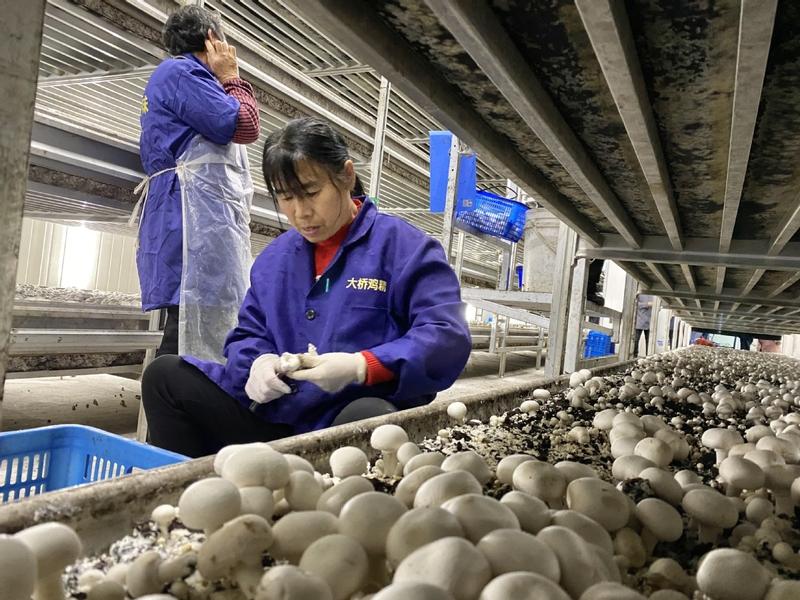 In this undated photo, a villager harvests mushrooms on a farm in Wanzhi district, Wuhu city of Anhui province. (ZHU LIXIN / CHINA DAILY)
In this undated photo, a villager harvests mushrooms on a farm in Wanzhi district, Wuhu city of Anhui province. (ZHU LIXIN / CHINA DAILY)
Jiang Xiaochong, from Shangshui village in the Wanzhi district of Wuhu, Anhui province, squatted beside a pond in front of his house, washing vegetables for his lunch just as he did when he was a child.
"It's not something I could have imagined doing again years ago, since the pond had become severely polluted and smelly," he said.
Wanzhi literally means "small land in the middle of the estuary". Located near the junction of the Yangtze and Qingyi rivers, the district is full of water resources.
The government has invested 300 million yuan to collect and process garbage and has issued policies requiring livestock to be raised on qualified farms, meaning the pollutants from the farms have to meet the requirements, according to Ding Meijian, deputy director of Wanzhi district's water resource bureau
But this village in inland Anhui, intersected with rivers and scattered with ponds, has seen its waters deteriorate due to increasing pollution from decades of wanton manufacturing and sprawling livestock.
For example, in 2015, the majority of surface water was lowered to Grade IV, the second lowest in China's five-tier water quality evaluation system, data from the local water resource authority showed.
This destroyed the villagers' sweet memories about their hometown, Jiang said, and the local government has been striving to improve the rural environment and people's livelihood since 2015.
A report by the Wanzhi government showed that the district's investment in pollution prevention projects reached 700 million yuan (US$108 million) last year, about 3.6 percent of its GDP.
The government has invested 300 million yuan to collect and process garbage and has issued policies requiring livestock to be raised on qualified farms, meaning the pollutants from the farms have to meet the requirements, according to Ding Meijian, deputy director of the district's water resource bureau.
In 2019, 185 unqualified livestock farms were closed, further cutting emissions, the report showed.
"Now, the proportion of surface water quality at and lower than Grade IV has been reduced to less than 20 percent," Ding said.
With the environment improving, Taoxin township, which governs Shangshui, has become more attractive-particularly its lotus plants, which have been blooming in its clean rivers and ponds since 2017.
ALSO READ: Xi urges efforts on rural vitalization
In 2019, over 500,000 tourists visited the township, bringing in over 80 million yuan, the township government said.
In addition to the lotus, the well-preserved original residences in the township, especially in Huaqiao village, have grown more popular as well.
"The old residences are a living art. They can tell us a lot of stories of how the villagers live," said Song Yu, a rural development expert in Wuhu, adding that a team of young artists are now protecting the village's original residences.
After studying the stories of the village and its residents, the artists have charted a plan for Huaqiao's tourism development, according to Song.
A former teacher from the Wuhu-based Anhui Normal University, he is now in charge of the rural revitalization business sector in Dingfeng Education, a local art training school.
He noted that Wanzhi district has more interest in maintaining the villages' traditional lifestyles while improving the environment.
When the school opened in Yingang village in 2006, there was a large group of manufacturing plants behind the campus.
In the 1980s, shortly after the country initiated the reform and opening-up process, Yingang villagers started to run manufacturing businesses, so the village soon emerged as one of the richest in Wanzhi district, which had been Wuhu county until earlier last year.
"As the firms developed, pollution became a problem," said Xia Yunlong, an executive of the school.
"By 2015, the local government had closed the firms that failed to tackle the pollution problem and relocated others to the city's modernized industrial development areas," Xia said.
As a result, the vacant plants were left for the government's disposal, which triggered debates.
The school's proposal to build the area into a hub of art-related startups was supported by the government, Xia said.
The school renovated the plants into classrooms, conference venues and offices for startups, making the area a popular site for tourists, he said.
To date, 126 firms have been attracted to or founded in the area, which is named Yingang Art Creation Town. Their main business includes art training and design.
READ MORE: Premier Li stresses innovation to bolster rural development
"Operating revenue of the firms in 2020 had reached more than 400 million yuan by the end of November," said Xia, adding that many of the startups have being engaged in reshaping the local villages' economy.
"Take Huaqiao village as an example. We tell the villagers to do farming in a more ecological way to improve their products' quality, and we design the brands and packages for the products," Song said.
He said the firms also help to promote the products through online and offline channels and attract tourists to the village with integrated services including catering and homestay.


